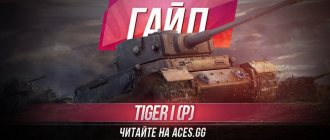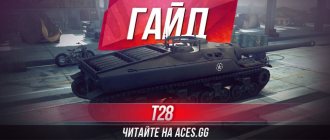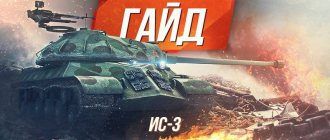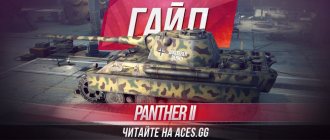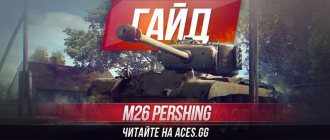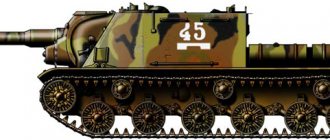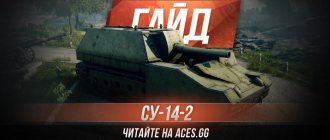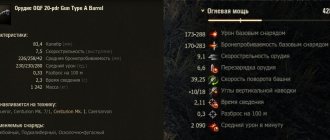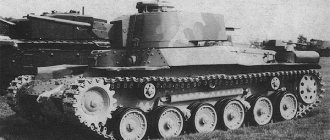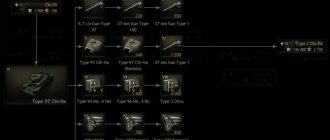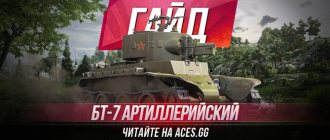Hello to all supporters of truly armored vehicles, aces.gg is with you! As you may have guessed, now we will talk about a real heavyweight, who can deservedly be called legendary. We will talk about the Soviet heavy tank of the eighth level, here is the KV-4 guide.
Without a doubt, we can say that this heavy load has been in the hangar of a huge number of players; many have kept it for themselves and roll it out from time to time. Let's take a closer look at the KV-4's characteristics from all sides and you will understand that this unit is really worthy of attention.
TTX KV-4
First of all, I want to say that with a safety margin of 1700 units, our hero really justifies his title of a heavy tank; the figure is impressive. But there is a downside to this coin: the basic viewing range is very poor - a paltry 350 meters.
Another strong point of the tank, of course, is the armor. In this aspect, the KV-4 performance characteristics look very advantageous, just take the body. Despite the lack of tilts in the frontal projection, we can quite successfully tank our classmates, but if we stand sideways to the enemy at a good angle, penetrating us will be a problem even for level ten vehicles.
In view of the above, it will be easier to penetrate the KV-4 World of Tanks into the turret. Don't think about it, this element of the tank is also strong, but there are vulnerable areas. For example, we have a huge machine-gun nest on the roof, the thickness of which leaves much to be desired, and the base of the tower can also be considered a weak area.
In terms of armor, you just need to remember that our gun mantlet is easily shot through by top guns, and in the front part of the KV-4 hull there are tanks and if the NLD is penetrated, there is a fairly high chance of a fire.
Of course, you have to pay for powerful armor, and given our enormous weight and large dimensions, the KV-4 WoT tank is quite slow. We have at our disposal quite good dynamics for such a giant, but we can’t boast of maximum speed, much less maneuverability, we drive slowly and take even longer to turn.
Tank building on the verge of common sense
On March 11, 1941, Soviet intelligence transmitted information “to the top” that the production of heavy tanks had been launched in Germany. The largest of these, the Type VII, allegedly weighed 90 tons and was armed with a 105 mm cannon. The Soviet leadership took the intelligence reports seriously. Accordingly, the work of the designers, who were tasked with creating a worthy opponent for German heavy tanks, began to boil. The result of this work was several extraordinary projects of KV-4
and
KV-5
.
Fear has big eyes
Partly, the intelligence information turned out to be correct, since by the middle of 1940 a project for the VK 65.01 heavy tank was ready, which actually had the designation Pz.Kpfw.VII. One of the tank variants was supposed to be armed with a 105 mm gun, but only 20 calibers long. In mid-1940, development began on the 36-ton VK 36.01, which was also called the Pz.Kpfw.VI Ausf.B. This is exactly the mass of the Type V tank mentioned in the reconnaissance report. Information about real cars was mixed in it with rumors. These rumors, however, created such a wave that plans for the production of heavy tanks in the Soviet Union were radically revised.
Longitudinal section of the KV-4 developed by Dukhov. It is clearly noticeable that the tank strongly resembles an elongated T-220
It is believed that the flywheel of the program to create Soviet super-heavy tanks began to spin on April 7, 1941, when the Council of People's Commissars of the USSR and the Central Committee of the All-Union Communist Party of Bolsheviks issued resolution No. 827-345ss. In reality, it all started two weeks earlier. Having studied the information received from intelligence officers, the Main Armored Directorate of the Red Army (GABTU KA) came to the conclusion that the 90-ton Pz.Kpfw.VII was most likely armed with a tank version of the 105-mm Flak 39 anti-aircraft gun. Such a gun was purchased in 1940 Soviet commission. After studying the results of firing the Flak 39, it was concluded that more or less effective protection from this gun is possible with an armor thickness of at least 130 mm.
On March 21, 1941, tactical and technical requirements were drawn up for the tank, which was to receive the KV-4 index. Its combat weight was estimated at 70–72 tons. At the same time, the front of the hull and the turret along the perimeter were to receive armor 130 mm thick, and the sides of the hull - 120 mm. It was planned to use a 107-mm F-42 (ZIS-6) cannon, as well as 3 machine guns, as weapons. At the same time, at the end of the document it was stipulated that 2 tanks should be built - with 76 mm (we were talking about ZIS-5 with 3-K anti-aircraft ballistics) and 107 mm guns. The ammunition load for the 107 mm cannon was supposed to be 70–80 rounds. An engine with a capacity of 1200 horsepower was provided as a power plant. As a temporary measure, it was planned to use the 850-horsepower V-2CH engine. With a more powerful engine, the tank's maximum speed was estimated at 35 km/h.
By March 27, a draft resolution of the Council of People's Commissars of the USSR and the Central Committee of the All-Union Communist Party of Bolsheviks was prepared “On the production of prototypes of heavy tanks.” According to him, both models of the new heavy tank were planned to be produced by November 1, 1941. The Kirov Plant prepared drawing documentation by July 17, and the Izhora Plant shipped hulls and turrets by October 1. By September 1, Plant No. 92 was shipping one 76-mm ZIS-5 cannon and one 107-mm ZIS-6 cannon.
As for the power plant, considerations were expected within 10 days on the development of engines based on the V-2 and M-40. By V-2 we meant the V-2SN engine, but with the second engine the situation is more interesting. This engine, which was of aviation origin, was produced at the Kirov plant. Its standard power was 1000 horsepower, and there was also a modification of the M-40F boosted to 1500 horsepower.
The sixth paragraph of the resolution contained considerations regarding the transportation of the designed tanks by rail. The maximum that the People's Commissariat of Railways (NKPS) could offer at that time was four-axle platforms with a lifting capacity of 60 tons. Of course, they were not suitable for a tank weighing more than 70 tons.
N. L. Dukhov, one of the creators of the KV-1 and IS-3 tanks. It was his design of the KV-4 heavy tank that won the competition held in April 1941
However, by April 7 the situation had changed greatly. Instead of the KV-3, which was a redesigned T-150 weighing 50 tons, the development of a tank with the same index, but with a combat weight of 68 tons, 120 mm frontal armor and a 107 mm gun, was launched. The approach to the KV-4 has also changed. Its combat weight increased to 75 tons, while a possible increase in armor thickness to 140–150 mm was envisaged. The thickness of the sides reached 125 mm. The development deadline was tightened: the layout and technical design had to be submitted by June 15, and the hull and turret were expected by August 15, 1941.
But that was not all. Instead of the KV-4 with a 76 mm cannon, Resolution No. 827–345ss of the Council of People's Commissars of the USSR and the Central Committee of the All-Union Communist Party of Bolsheviks obliged the Kirov Plant to develop a tank that, in terms of its characteristics, would clearly be a response to the ghostly Pz.Kpfw.VII. Like the German vehicle, the designed tank, designated KV-5, was supposed to have a combat weight of 90 tons. Its armament and power plant were planned to remain at the level of the KV-4. The increase in mass was achieved due to the armor, the thickness of which reached 170 mm in the frontal part, and 150 mm along the sides of the hull. The crew size of both tanks was estimated at 6–8 people.
According to the decree, drawings for the KV-5 had to be submitted to the Izhora plant by July 15, and by August 1, documentation for the tank and its full-size mockup had to be submitted. The Kirov plant received the hull and turret by October 1, and the tank itself was scheduled to be built by November 10, 1941.
Breaking Bad
The requirements for the new tanks meant that the KV-4 and KV-5 would have to be designed, if not from scratch, then certainly after a major revision of the concept. Zh. Ya. Kotin, who headed the design bureau of the Kirov plant, was faced with a difficult task that had to be solved quickly.
Joseph Yakovlevich adopted an idea that at the end of the 30s, when designing medium and heavy tanks, was used by the design bureau of pilot plant No. 185. During the development of the 115 and T-100 tanks, several versions of the tank were tested at once, which were prepared by different groups. Kotin went further and included almost all engineers from the Kirov plant design bureau in the development of the KV-4 concept. For greater motivation, the most successful works, by agreement with the director of the Kirov plant I.M. Zaltsman, decided to give bonuses.
Work began in earnest on the tenth of April 1941. The terms of the competition limited the engineers within fairly loose limits. The engine (M-40), combat weight (80–100 tons) and turret installation of weapons were discussed. At the same time, a multi-turret arrangement was also allowed. The main weapon was a 107-mm ZIS-6 cannon, to which, at the insistence of the military, a second 45-mm cannon was added. A total of 27 projects were submitted to the competition. The scope of the article does not allow us to talk about all of them, so further we will talk about the most successful and interesting works.
Installation of weapons in the KV-4 turret developed by Dukhov
N.L. Dukhov coped with the task most successfully. Without trying to engage in “fantasies on the topic,” Nikolai Leonidovich approached the issue in the most conservative way and actually developed the T-220 heavy tank. He slightly lengthened and expanded the body of the vehicle, as a result of which the number of road wheels increased to 8 per side. The development of the turret, which was very reminiscent of the enlarged turret of the T-220, also followed an evolutionary path. The commander's cupola, equipped with a DT machine gun, was also taken from this tank (with modifications). The armament, consisting of a 107-mm ZIS-6 cannon and a 45-mm tank gun, was housed in a single installation.
The combat weight of the Dukhov tank was supposed to be 82 tons, and it was the lightest of the KV-4 projects presented. The armor fully complied with the specified tactical and technical requirements, and the maximum speed of the tank was estimated at 40 km/h. It was this car that was ultimately chosen as the winner.
KV-4 developed by Kuzmin, Tarapanin and Tarotko. The casemate installation makes the tank more like a self-propelled gun. By the way, in the spring of 1941 there was talk of developing the 107th self-propelled gun based on the KV-4
Second place was taken by the project of a team consisting of engineers K. I. Kuzmin, P. S. Tarapanin and V. I. Tarotko (in other documents, S. V. Mitskevich is indicated instead of Tarapanin). Subsequently, Kuzmin and Tarotko established themselves as outstanding hull designers. The KV-4, which this team presented, turned out to be extremely unusual. Its fighting compartment was moved to the stern, and the engine was placed in the central part of the hull. The engineers placed the main armament of the tank in a casemate installation with large horizontal aiming angles. The 45-mm cannon ended up in a separate turret. The combat weight of the tank according to the project was 88 tons, the estimated speed was 36 km/h.
Tseitz's KV-4 was distinguished by an unusual hull shape and the absence of a 45-mm cannon
Third place was taken by the project of N.V. Tseits. Nikolai Valentinovich was the most experienced engineer in the design bureau team of the Kirov plant. He began his activities back in the 20s, and had a whole galaxy of machines behind him. The project proposed by Zeitz was progressive and conservative at the same time. The designer refused the second gun, considering it an unnecessary rudiment. A feature of Zeitz’s project was a fairly high turret, which made it possible to place 107-mm unitary shells vertically along its sides. In theory, such a concept made it possible to significantly simplify the work of the loader. To compensate for the significant height of the tower, the hull was made as low as possible. Between the management department and the logistics department, Zeitz created a kind of “step.”
Ermolaev's KV-4 was designed in such a way that the second turret could be easily removed from it. Here we remember the story of the SMK and its third tower, which Stalin himself allegedly “removed”
The project of another leading designer of the Kirov plant was highly appreciated. A. S. Ermolaev proposed the tank in two versions at once. In the first version, the 95-ton KV-4 had two turrets. A 107 mm cannon was installed in the main turret, and a 45 mm gun was placed in the second turret, located in the front part of the hull. The second option differed only in that the turret with the 45-mm cannon, and with it 5 tons of combat mass, was removed. It seems that Ermolaev remembered the QMS, the development of which he once led. It is worth noting that the scheme proposed by Ermolaev was used by the authors of at least five more projects.
KV-4 engineer Kruchenykh, the heaviest of the projects. An insert erroneously designating it as a KV-5 was made by N. F. Shashmurin
The heaviest KV-4 was a project by engineer G.V. Kruchenykh, who later created the turret of the IS-3 heavy tank. Like the tank developed by K. I. Kuzmin, P. S. Tarapanin and V. I. Tarotko, this vehicle had an engine located closer to the bow. The tank had two turrets, and they were placed in two tiers - one on top of the other. The third tier was the commander's turret with a machine gun. The KV-4 Kruchenykh weighed as much as 107 tons. The scheme proposed by the engineer with towers placed one on top of the other was used in five more projects.
Shashmurin’s KV-4, or, as he himself called his tank, B.S. ("ravings of a madman")
Finally, it is worth mentioning the KV-4 developed by N. F. Shashmurin. Nikolai Fedorovich himself called the topic of KV-4 and KV-5 BS, which stood for “the ravings of a madman.” No one can tell you better than him what kind of project was proposed to him:
“Having received, along with other leading employees of the design bureau, the task of developing a project for such a cyclops, but certainly a multi-tower one, I, without sharing the proper optimism regarding the last condition (multi-tower – how long ago did we abandon the “Mur-Meriliz” included in the QMS), did “ knight's move." In general, he abandoned the turret installations, and repeated what he had done on the KV-1 tank when installing the M-10 howitzer, 152 mm caliber, that is, a caponier (cutting) superstructure on the armored hull. And since a new, almost super-heavy tank, the KV-3, had already been created, I decided not to think too hard about a supernew tank. Having thrown off the turret, he repeated the previous version as a high-power self-propelled gun, installing a 107 mm Grabin cannon there. Indicating in the explanatory note that under certain conditions the gun can be removed, and instead of it, a rifle squad of infantrymen can be placed in the fighting compartment. This option was not allowed into the competition because the conditions were not met - higher protection, tank weight of 80–100 tons, turret (multi-turret) weapon installation. To avoid unnecessary confrontation, I compromised. Considering that a super-heavyweight cannot be a tank, having adopted the specified protection, he invested in a weight of about 90 tons, retained the caponier installation of the main gun, and installed a serial turret of the KV-1 tank on the roof of the lowered cabin. It ended with I.M. Zaltsman really liked this option (taking into account its “reasonable,” as he put it, versatility) and I received a second prize in the amount of 1000 rubles. This is cool. I bought a fur coat for my wife with this money.”
Fallback option
On May 9, 1941, the results of the competition for the KV-4 project were summed up. Dukhov, who took first place, received 5 thousand rubles. K.I. Kuzmin, V.I. Tarotko and S.V. Mitskevich received 3 thousand rubles for their project, which took second place. N.V. Tseits, A.S. Ermolaev and L.E. Sychev received 2 thousand rubles each for their work. N. F. Shashmurin received 1,500 rubles for his work.
At the same time, design work on the KV-4 was progressing slowly. According to the decree, the completed technical design and model of the KV-4 should have been submitted by mid-June, but judging by the correspondence, there was no significant progress in this matter. Things got to the point where Marshal Kulik intervened and demanded that the work be speeded up. How much this helped is unknown, since his letter was dated June 12, and 10 days later the war began.
The work of another interested party, the People's Commissariat of Railways, proceeded at a completely different pace. Beginning in the spring of 1941, there was active correspondence between the GABTU and the NKPS regarding platforms for new tanks. Initially, it was about 72 tons of combat mass, but already in April 1941, other figures were mentioned - 80-100 tons. For 1941, GABTU ordered 200 such platforms, and for 1942 – as many as 1,500 pieces. As a result, the railway workers, unlike the tank builders, completed their mission. Already in 1941, production of 120-ton six-axle platforms began. Their length and carrying capacity were, as they say, with a reserve.
Longitudinal section of the KV-5 hull. As you can see, it has a lot in common with Zeitz's KV-4
As for the KV-5, until June 1941, virtually no work was carried out on it. Judging by Zaltsman’s letter about the bonus for the KV-4 competition, something similar was planned for the KV-5, but then the idea was abandoned. Kotin’s idea with the competition was not supported, deciding to use the most successful variants of the KV-4. Since Dukhov’s project was put into circulation, and the vehicle with a rear-mounted fighting compartment turned out to be too advanced, the choice fell on the further development of the KV-4 developed by N.V. Tseits. Nikolai Valentinovich was appointed senior engineer of the machine. Also, other engineers who participated in the KV-4 competition were involved in the development of the KV-5. K.I. Kuzmin worked on the tank hull, L.E. Sychev worked on the turret and weapon installation. The design of the chassis was entrusted to N. T. Fedorchuk, who had extensive design experience.
A rather strange situation has developed regarding the KV-4 and KV-5. On the one hand, the GABTU took the position that the KV-3, the development of which was in full swing, was a temporary solution, and in 1942 it was going to be replaced by one of these two tanks. Which tank would be chosen (KV-4 or KV-5) was supposed to be determined based on the results of joint tests.
On the other hand, the KV-4, the project of which was approved back in May, was practically not implemented in the form of factory documentation. This cannot be said about the KV-5, documentation for which continued to be produced even after the start of the Great Patriotic War and the order to curtail work. As its development progressed, the manufacturing technology was even changed. The last drawings were ready in August 1941, when the Germans had already approached Leningrad.
Lenivets KV-5, drawing dated early August 1941
As mentioned above, the KV-5 was based on the Zeitz KV-4. The idea with a high turret and the lowest possible hull was developed further, with an emphasis on greater manufacturability. Firstly, the steps under the tower were abandoned. Instead, the driver-mechanic received a separate wheelhouse, and the radio operator-gunner received a machine-gun turret. Thanks to this, the height of the body in the front part was only 920 mm. Secondly, they abandoned the rounded shape of the main tower, making it more technologically advanced. By the way, in the finale, the thickness of the armor of the frontal part of the tank increased to 180 mm, which made it practically invulnerable to artillery of that period in the frontal projection.
Tanks of ghost battles
Typically, the development of the KV-4 and KV-5 is viewed as a pointless waste of time and money. In many ways this is true. Even if the war had not started in 1941, it is unlikely that these tanks could have made it into production. However, we should not forget that there is no smoke without fire. The mistake of Soviet intelligence, which reported that the potential enemy had heavy tanks, had objective grounds.
Correspondence from Krupp at least indicates that a 15 cm long 40 caliber gun for the VK 70.01 was designed back in March 1941
A study of documents in the Bundesarchive showed that back in March 1941, the Krupp concern began developing a certain vehicle designated as 15 cm K. L/40 in Sfl (that is, a self-propelled 149 mm gun). So, in the fall of 1941, this project turns into... 15 cm LL/40 für VK 7001. Yes, yes, we are talking about the same VK 7001, which is known as Pz.Kpfw. Löwe, and how... Pz.Kpfw.VII. The combat weight of this tank was also 90 tons, and a 105-mm cannon was supposed to be one of the armament options. Who knows, maybe our intelligence learned about this Pz.Kpfw.VII. In any case, it was not at all the VK 7001 that is now widely known. The Germans began to use rational angles of inclination of armor plates in the designs of their tanks only in the fall of 1941, after becoming familiar with the T-34.
Literature and sources:
- TsAMO RF
- BAMA (Bundesarchiv)
- Author's archive
- Archive of Gennady Malyshev
- Archive of Alexander Smirnov
- Domestic armored vehicles. XX century Volume 1. 1905–1941, A. Solyankin, M. Pavlov, I. Pavlov, I. Zheltov, Eksprint, 2002
- 50 years of Confrontation. On the issue of the development of domestic tank building. N. F. Shashmurin, 1987
gun
Now let's talk about the pride of every tank - its weapons. We have a good, I would even say comfortable, gun installed on board, but it has its advantages and disadvantages.
So, the KV-4 gun has a decent, but far from the largest alpha strike at the level. But we get a decent rate of fire, due to which we are able to produce approximately 1860 damage per minute, the result is quite good.
Among other things, the KV-4 World of Tanks gun has very good parameters for armor penetration with a basic shell, but it’s better to play it safe and purchase 10-15 gold shells before the battle, after all, we often have to fight against levels 9 and 10.
As for accuracy characteristics, everything is relative. On the one hand, we were given a fairly comfortable dispersion, but the stabilization and, especially, the gun aiming speed of the KV-4 WoT let us down, we will need to correct these issues.
By the way, the vertical aiming angles of our giant are also rather weak, the gun goes down only 6 degrees, so you won’t be able to play really well depending on the terrain.
Tips for the game.
Being at the top of the list, in no case should you sit behind - you should go forward, use your good armor, since you will very often catch non-penetration from tanks below the level.
If you are up against tanks of a higher level, then more often you need to act from behind, not go forward, and use the advantage of your gun, namely very good accuracy. Because against levels 9-10 our armor is critically lacking. Also, if the opposite team has high-level artillery and you stand still after the light, all this very often ends with a trip to the hangar, because our tank is very desirable for artillery and there are reasons for that. Yes, the KV-4 is perfectly armored all around, but the top armor of the tank is 20-30 mm and an armor-piercing shell from artillery can easily penetrate us and, as a result, swanshot us. I would also like to note the dimensions of the tank - it is not small and it is difficult to miss it, and the speed of 30 km/h is not very high. Our tank is very vulnerable to high-explosive shells; any hit to the forehead will cripple our gun.
Let's look at the options for action on various maps. For example, on Himmelsdorf, you can easily tank and push in the banana direction. You can also easily tank damage through the sides on square D7, to do this you need to stand up so that the NLD is not visible to the enemies, but only the sides, which they will never penetrate, because the angles are very large and I received ricochets from the BL-10.
The second example is the Redshire map. In square B9 there is a good save from artillery, subject to respawn from the first base, if anyone doesn’t remember this is the lower base.
In this square, you control the entire eighth line, preventing opponents from breaking through it. After pushing through the direction, you can freely kill the tank on the mountain, the artillery on the “A” line and capture the base.
Advantages and disadvantages
To better understand the mechanics of playing a tank, you need to be well aware of all its strengths and weaknesses. The case with the KV-4 is no exception, and to make it easier for you to navigate the variety of characteristics, we will highlight the main nuances separately. Pros: • Not a bad alpha strike; • Excellent penetration parameters; • Large safety margin; • Excellent booking; • Decent dynamics for its weight. Cons: • Very small review; • Poor mobility and agility; • Long mixing time; • Large dimensions; • Vulnerable location of fuel tanks.
Crew skills.
for the entire crew is repairs.
Second skill: individual for each crew member Commander - Sixth Sense Gunner - Sniper Mech-water - King of the Off-Road Loader - Intuition and non-contact ammunition Radio operator - Radio interception
Third skill: individual for each crew member Commander – Jack of all trades Gunner – Smooth rotation of the turret Mech-water – Smooth movement Loader – Fire extinguishing Radio operator – Fire extinguishing
Fourth skill: individual for each crew member Commander – Eagle Eye Gunner – Master Weaponsmith Mech-Water – Virtuoso Loader – Camouflage Radio Operator – Camouflage
Equipment for KV-4
To feel more comfortable in battle, it is very important to correctly select and install additional modules on the tank, because this is an excellent opportunity to improve the vehicle’s parameters. In the case of KV-4, the following equipment is installed: 1. – you should never miss the opportunity to increase your DPM, so this module is mandatory. 2. – earlier we talked about weak stabilization and poor aiming speed, this option will improve the accuracy of the gun. 3. – all other things being equal, this module also looks very worthy, because we get a boost to several important parameters at once.
Due to our very poor visibility, it can only be properly compensated by installing , but such a development, to put it mildly, leaves much to be desired. So, as an alternative to the third point, you can put it on the KV-4 WoT heavy tank to improve the accuracy even more, or you can spend money on it, because with our dimensions and poor mobility, artillery will cause a lot of inconvenience.
Summary table of the main characteristics of projects
| Constructors | Weight | Main caliber | Additional caliber | Max. Speed | Frontal armor | Crew | Length | Width | Height |
| S. Fedorenko | 107 mm in turret | 45 mm in the turret at the top | 35 km/h | ||||||
| G. Kruchenykh | 107.7t | 107 mm in turret | 45 mm in the turret at the top | 34 km/h | 180mm | 9 people | 9.13m | 4.03m | 3.78m |
| K. Buganov | 93t | 107 mm in turret | 45 mm in the turret at the top | 42 km/h | 190mm | 6 people | 7.70m | 3.80m | 3.9m |
| F. Marishkin | 107 mm in turret | 45 mm in the turret at the top | 40 km/h | ||||||
| G. Moskvin | 107 mm in turret | 45 mm in the turret at the top | 31.3 km/h | ||||||
| N. Strukov | 92t | 107 mm in turret | 45 mm in the turret at the top | 36 km/h | 186mm | 6 people | 8.6m | 4 m | 3.8 m |
| A. Ermolaev | 107 mm in turret | 45 mm in turret | 35 km/h | ||||||
| L. Sychev | 107 mm in turret | 45 mm in turret | 35 km/h | ||||||
| L. Pereverzev | 100t | 107 mm in turret | 45 mm in turret | 39 km/h | 125mm | 6 people | 6.5m | 3.8m | 3.32m |
| Bykov | 107 mm in turret | 45 mm in turret | 36 km/h | ||||||
| Unknown | 107 mm in turret | 45 mm in turret | 37 km/h | ||||||
| Unknown | 107 mm in turret | 45 mm in turret | 40 km/h | ||||||
| M. Kreslavsky | 92.6t | 107 mm in common turret | 45 mm in common tower | 32 km/h | 125mm | 6 people | 9m | 4m | 3.225m |
| N. Dukhov | 82.5t | 107 mm in common turret | 45 mm in common tower | 35 km/h | |||||
| N. Shashmurin | 92 t | 107 mm in case | 76 mm in turret | 35 km/h | 188mm | 7 people | 10m | 4m | 3.88m |
| P. Mikhailov | 86.5t | 107 mm in turret | 45 mm in case | 21 km/h | up to 180mm | 5 people | 9m | 3.6m | 3m |
| G. Turchaninov | 107 mm in turret | 45 mm in case | 35 km/h | ||||||
| N. Zeits | 90t | 107 mm in turret | Absent | 36 km/h | 125mm | 7 people | 8.35m | 4.03m | 3.62m |
| P. Tarapatin/K. Kuzmin/V. Tarotko | 88t | 107 mm in a turret with an edge. UGN | 45 mm | 36 km/h | 125mm | 6 people | 9.26m | 3.79m | 3.175m |
| V. Pavlov | 45 mm in a turret with ogre. UGN | 38 km/h | |||||||
| D. Grigoriev | 45 mm in a turret with ogre. UGN | 35 km/h |
Tactics for playing the KV-4
Due to the fact that we have in our hands a very armored tank for its level, but at the same time a large and slow tank with a disgusting view, on the KV-4, combat tactics come down to taking a position on the first line, close encounters and methodically pushing through the chosen direction.
Be prepared for the fact that you will not have enough movement speed to change the flank, much less go back, so when playing the KV-4 WoT you need to immediately think through a strategy and constantly monitor the situation in battle.
Regarding head-on collisions, for which our unit is best suited, we must always try to tuck the body and dance between shots in order to make it more difficult for the opponent to target our vulnerable areas. But even more beneficial on the KV-4 World of Tanks is side-tanking. Showing the side at an acute angle, even top vehicles cannot always penetrate us, not to mention the battles at the top of the list.
The main thing you should always remember is to be afraid of artillery, because due to the shed’s slowness it’s not so difficult to hit us, and you should also be wary of mobile STs and LTs. It won't be difficult to spin the heavy KV-4 tank. To do this, try not to be alone, because it is much better if, with your help, a powerful fighting fist is created, which you will lead to victory.
Links
Medium tanks T-34 T-34-57 A-43/T-34M ·
A-44
·
KV-13
·
T-43
· T-34-85 · T-44 ·
T-34-100Heavy tanks KV-1 · KV-2 · T-150 ·
KV-220
·
KV-3
·
KV-4
· KV-1s ·
KV-5
·
KV-1K
· KV-85 ·
KV-9
·
KV-100
·
KV-122
·
EKV
· IS-1 · IS-2 ·
Object 244
·
Object 245
·
Object 248
· IS-3 ·
ST-1
·
IS-5
·
IS-6Flamethrower and chemical tanks KV-6 · KV-8 · OT-34 ·
KV-12Surrogate tanks NI-1 · Light self-propelled guns ZIS-41 ·
76.2 mm assault support gun
·
I13.73-SU
·
I13.75-SU
·
I13.76-SU
· SU-76 ·
SU-71
·
SU-15
·
SU-16
·
SU-IT-45
·
SU-74A
·
SU-74B
·
SU-74D
·
GAZ-75
·
NATI-TSAKB
·
Tank destroyer (MVTU project)
·
SU-85A
·
KSP-76
·
OSU-76
·
SU-85BMedium self-propelled guns U-34 · SG-122 · SU-122 ·
SU-D25
SU-122М
·
SU-85-I
· SU-85 ·
SU-122-III
·
SU-85-IV
· SU-76i ·
SU-D15
·
SU-85BM -I/SU-85BM-II
· SU-100 ·
SU-122P
·
SU-122-44
·
ESU-100
·
SU-100M-1
·
SU-100M-2
·
SU-101 · SU-102Heavy self-propelled guns KV-7 ·
U-18
·
U-19
· SU-152 ·
S-51
·
S-59
· ISU-152 · ISU-122 · ISU-122S ·
ISU-152-1
ISU-152-2
· -
122-1
·
ISU-122-3
·
ISU-130
·
ISU-152 model 1945Surrogate self-propelled guns ZIS-30 · HTZ-16 ZSU ZIS-43 ·
T-90
·
SU-72
·
SU-11
· ZSU-37MLRS BM-8-24 BM-13-16 BM-8–48 BM-13N BM-31-12 Armored cars LB-62 · · BA-64
Armored personnel carriers TB-42 ·
BA-64E
·
B-3Armored tractors Object 42 ·
ZIS-22MB
·
ATP-1Combat snowmobiles and snowmobiles TsAGI-AHT-IV · NKL-16 · 02SS · NKL-26 · RF-8 (GAZ-98) ·
BA-64-ZTorpedo wedges ET-1-627 italics experimental samples and those that did not go into mass production were identified
Now about the most important thing - about armor
When this tank was introduced into the game, the game itself was somewhat different: there weren’t a bunch of tank guns with huge armor penetration, there weren’t high-explosive tanks and universal mobile artillery tanks with armor like the TT, the players didn’t have that much gold. In those distant times, the KV-4 was a real monster, crushing its rivals without any difficulty.
Now this tank is going through hard times, so bad that the developers are planning to rebalance it, or even remove it from the pumping branch altogether, replacing it with another tank.
History of creation
Work on the creation of the project began in 1943 at ChKZ in Chelyabinsk in SKB-2, at the time when the IS-122 was put into service. The creation of the project was first led by L.S. Troyanov, a little later M.F. Balzhi, the creator of the IS-3, was appointed to the position of manager.
The project, designated “K,” was originally intended to combat German heavy tanks, as the main enemy of the Panther, Tiger and their modifications. The required characteristics and drawing of the machine's components were accepted on December 10, 1943, and 4 months later a wooden model was created.
During the design, the layout of the IS tank was taken as a basis, with modernization and changes to the machine components.
The armor protection of the vehicle was significantly increased, which contributed to changes to the chassis due to the increased weight. So the number of road wheels increased to 7 on each side of the vehicle, and the width of the tracks increased to 730 mm. In addition, the power of the existing engine installed on the IS-3 was clearly insufficient for such a heavy vehicle.
The design bureau at ChTZ - SKB-12 (engaged in the development of diesel engines) came to the rescue with a new 12-cylinder V-12, designed on the basis of the famous V-2 engine. Also, towards the end of the design of the machine, a new transmission was developed. The increase in booking also entailed a change in the turret mounting with a new rotation control system.
In mid-spring 1944, the project was approved and received the name “Object 701”. There were six versions of the project in total, the main difference being the installed artillery system.
- Object No. 701-1. This prototype, released in April 1944, was equipped with a 122 mm D-25T artillery system. After field tests, in June 1944, the project was aimed at eliminating the identified deficiencies.
- Object No. 701-2. The only difference between the project and the previous one was the installed 122 mm S-34-II artillery system.
- Object No. 701-3. This sample was equipped with a C-34-I gun with a caliber of 100 mm. Along with a decrease in the caliber of the gun, the thickness of the frontal armor increased by 20 mm (in the first two versions, the thickness of the “forehead” was 140 mm, the third version had 160 mm). In order to reduce the negative impact on cross-country ability due to increased weight, the length of the vehicle has been increased. But the measures taken had little effect on improving the driving performance of the project.
- Object No. 701-4. This object is a modernized No. 701-1. The main difference was the modernization of the vehicle's chassis. After running tests at 1,160 km, transmission shortcomings were revealed, and the car was also sent for improvement.
- Object No. 701-5. The project was manufactured in the late autumn of 1944, the vehicle was based on projects 701-3 and 701-4. The main difference was the increase in the armor protection of the “forehead” of the turret to 250 mm, and the armor protection of the rear of the tank was increased to 120 mm. A 122 mm art. was supplied to the site. D-25T system.
- Object No. 701-6. The latest version of the project, testing of which was completed on April 21, 1945, differed from the previous one in the modernized chassis.
And if after all the tests were carried out and the shortcomings were eliminated there were no questions about the vehicle, then in the case of object 701 being equipped with a tank gun, the developers faced a dilemma. The choice was not easy - these were guns with a caliber of 122 mm, S-34-II and D-25T. And if the first had great accuracy, then the second was mass-produced. The last factor became convincing in the decision to equip object 701 with the D-25T artillery system.
The new tank turned out to be bulky and was inferior to the IS-3 due to its greater mass and low maneuverability, but won due to stronger armor protection. It was the latter factor that contributed to the launch of the object into series.
A year later, on April 29, 1946, the tank was put into service and received the name IS-4; by September of the same year, 25 units were manufactured. This batch was intended for testing; a month later, on October 8, the IS-4 was put into production. The establishment of mass production proceeded very slowly and in three months it was possible to produce only 20 units.
The further fate of the tank
All 244 IS-4s served in units in the Far East and were withdrawn from service in the 60s. The reason for refusing further production of the tank was the high cost and complexity of production, which excluded the possibility of mass production in the event of a war with a potential enemy. The excessive weight of the tank reduced the possibility of transportation by rail or road transport.
In addition, the chassis diseases that appeared during the production of the first samples and testing were never completely eliminated. The tank did not take part in military conflicts in the second half of the 40s and until the 60s, probably due to the difficulty of transporting it to a possible theater of combat and the high cost of maintenance. The tanks remaining at the end of their service became targets during firing exercises, and the dismantled turrets with guns were installed as separate firing points on the border with China.
Today, several IS-4 units have been preserved and can be seen both in the museum exhibition and as a monument:
- museum of armored vehicles in Kubinka;
- park of the RA Officers' House in Chita;
- monument in Zabaikalsk.
By the time the IS-4 was launched into mass production, the war had come to an end, and accordingly, the main purpose of the vehicle, as a killer of German heavy tanks and self-propelled guns, was not in demand.
The high labor intensity, high cost of manufacturing the machine, heavy weight and unreliability of some units - all this contributed to the fact that the machine was discontinued after three years and subsequently did not take part in any military operations. Heavy tanks were gradually replaced by main tanks, which were not inferior in weapon power, but had improved dynamic characteristics. And the reduced weight of the main machines made them universal.
Description of design
Initially, the following requirements were presented to the machine being developed:
Armored hull and turret
The armored hull is welded, made of rolled plates and sheets of homogeneous steel, the turrets are welded, made of rolled plates and sheets.
Armament
Two guns were proposed as weapons: 107 mm ZIS-6 and 45 mm 20-K. To combat enemy manpower and lightly armored forces, it was also planned to install DS and DT machine guns. Some designers planned to use a flamethrower as an additional weapon.
Surveillance and communications equipment
It was planned to install 10-R radios on the tanks, as well as surveillance devices in the commander's cupola.
Engine and transmission
The power plant was presented as an aviation piston 12-cylinder V-shaped four-stroke water-cooled diesel engine M-40 with a power of 1200 hp.
Chassis
Torsion bar suspension, rollers with internal shock absorption.
